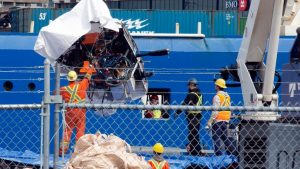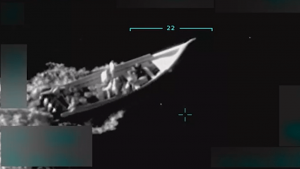The world of ocean exploration will forever remember 18 June, 2023, when Titan submersible with five persons on their way to see the wreckage of Titanic, died.
The search and rescue efforts for the missing Titan craft on 22 June, 2023, turned into a recovery operation after a Remotely Operated Vehicle, ROV, brought pictures of new heap of debris near the shipwreck of Titanic at the bottom of the ocean.
The debris was 1,600 feet from the bow of the sunk Titanic ship.
Those who have mapped the undersea area around the Titanic were sure of what the debris meant because there is nothing new, unmapped, in the site.
Soon, part of the debris was confirmed to contain the landing frame and rear cover of the Titan vessel. It imploded under 5,800 psi of water pressure overlying the site, near the Titanic shipwreck.
The pressure chamber where the crew were staying in Titan also imploded and was soon found among the debris in another heap nearby.
The Canadian vessel, Horizon Arctic, with an ROV recovered much of the debris and brought them ashore to Newfoundland on 28 June, 2023 leaving no one in doubt that the men inside the vessel are dead.

The pressure at that depth is 400 times the air pressure on land. It is like having 35 elephants lying over one.
Investigation is underway.

Titan, the diving craft with five persons onboard went missing in the morning of 18 June, 2023. It is a submersible — not a submarine.
A submarine is fully autonomous and capable of renewing its own power to operate equipment and transmit signals. A submersible, on the other hand, relies on a mothership on the surface. That surface vessel for the Titan was the M. V. Polar Prince.
The Titan, a 22-foot long carbon-fibre and titanium craft weighing 23,000 lbs (10.4 tonnes), is lightweight and strong with a speed of three knots. It is owned by OceanGate Expeditions.
It was carried out from St John’s, Newfoundland, by M.V. Polar Prince, 350 miles (563 kilometres) over the site that the Titanic sank in the North Atlantic, to dive nearly 13,000 feet down to the shipwreck on the ocean floor.
A U.S. Navy submarine typically, does not dive beyond 2,000 to 3,000 feet.
The Titan did not carry a beacon, an equipment that transmits emergency alarm signals, nor does it have a GPS. It also did not have a transponder: Those do not work at such depth.
It depended on the mothership for guidance using short text messages. The mothership, in turn, communicates with the outside using Starlink satellites.
The U.S. Coast Guard said Titan lost contact with the surface ship an hour and 45 minutes after it started the dive.
OceanGate says the Titan can take five people 4,000 metres — more than 13,100 feet — deep into the ocean. The capsule is designed by NASA to take the pressure from overlying water.
The five people in the missing submersible are: Stockton Rush, 61, the owner of OceanGate Expeditions; Hamish Harding, 58, a British billionaire and explorer; the British-Pakistani billionaire, Shahzada Dawood, 48, and his son, Suleman, 18; and Paul-Henri Nargeolet, 77, a French who has made 37 dives to the Titanic wreck site, most of them, in an unsuccessful recovery effort in 1987.
Stockton Rush was the pilot.
There is evidence that the weather was not too good at that time. Harding posted on Instagram a day before the mission: “Due to the worst winter in Newfoundland in 40 years, this mission is likely to be the first and only manned mission to the Titanic in 2023. A weather window had just opened up and the team is going to attempt a dive the following day.”
The expedition lasts eight days. It takes Titan about two hours to dive down and two hours up. The tourists peep for about an hour around the sunk Titanic using the flashlights of the submersible to see. They spend the rest of their expedition time on the mothership which spends about four days to the dive site from Newfoundand and back.
The loss of communication with the mothership was a disaster for the Titan. Visibility was poor and there was no way of knowing where the Titan was. Visibility is completely lost 3,000 feet into the ocean and it becomes pitch black.
The craft has taken tourists to see the Titanic three times since the company started in 2021 for a fee of $250,000 per tourist.
Mike Reiss, a New York television producer, was on the trip in 2022: “Yes, the sub that’s gone missing is the same one I took down to the Titanic. He told BBC Breakfast, “You sign a massive waiver that lists one way after another that you could die on the trip. They mention death three times on page one so it’s never far from your mind.”
David Pogue of CBS says in that incident, the submersible was “lost on the sea floor for a few hours but did not lose communication with its mother ship.” He was in the control room of the mothership: “They could still send short texts to the sub, but did not know where it was. It was quiet and very tense.”
Deep sea explorers however, say such is normal and that communication is lost and restored intermittently in such environment. You start to worry when it persists for up to half an hour.
Also, the Titan submersible had an automatic device that sheds added load that allows the vessel refloat to the surface after 16 hours. If the communication was intermittent and there was a minor problem, the mothership could have waited for it to resurface, and know it is resurfacing, without raising alarm.
The R.M.S. Titanic, the biggest ship in the world then, in its first trans-Atlantic voyage from Southampton, England to New York, in its fourth day in the trip on April 14, 1912, hit an iceberg and sank killing 1,500 people. A total of 2,200 people were on board.
The wreck was only discovered in 1985, in the North Atlantic Ocean at 3,800 metres (12,500 feet) depth, 370 miles off Newfoundland, Canada.
The site has become a great tourist attraction and understandably so.
However, a few people still wonder why the Western media were paying more attention to five billionaire tourists on a pleasure trip to see the Titanic than to the plight of thousands of illegal migrants who die crossing the Mediterranean from Africa to Europe.
Overall, there is a global outpouring of affection than blame for the crew of the missing Titan. They have just snacks and few bottles of water in the submersible. It was on Father’s Day and Dawood was taking his Rubik-playing son, Suleman, on a voyage of a lifetime.
Titan had 96 hours of oxygen in it. It is 22 feet by 9.2 feet by 8.3 feet which is barely enough space for one person to fully stretch his legs in the pressure chamber where the crew were staying. There is not enough room to stand up straight. They have only a small toilet onboard for their convenience and it has never been used.
The U.S. Coast Guard, Canadian, French and British authorities and airplanes and vessels were searching for the Titan over an extended area of 7,600 square miles or 19,683 sq kilimetres. In addition, they used sonar buoys to try to locate it under water.
They were also searching the open ocean should the submersible resurface without communications. The crew of Titan are shut-in and cannot open the vessel from the inside. They can suffocate when the craft runs out of oxygen even when afloat.
Roger Mallinson, is one of two people saved in the deepest underwater rescue in Guinness Book of World Records, while laying transatlantic telephone cables. His colleague was Roger Chapman. The hatch to the self-contained aft sphere of their submersible, Pisces III, opened and it got flooded.
They scurried to the safe part as they sank 1,575 feet (480 metres) down to the ocean floor. They were trapped for 80 hours from August 29, 1973 to September 1, 1973 at 150 miles off Cork in Ireland.
Their communication system was working so, they called the mothership and were located and rescued with just 12 minutes of oxygen left.
Chapman died in 2020 and Mallison, 85, said time is of the essence.
The search intensified for Titan submersible and the Navy deployed hyperbaric recompression chamber. A hyperbaric recompression chamber treats lung decompression from rapid decrease in pressure. They also had Flyaway Deep Ocean Salvage System for recovering heavy equipment under water.
Two of the victims in the missing Titan are hugely, experienced explorers. There were reports of sounds of intermittent bangs picked by rescuers’ equipment on 21 June, 2023 from the search area in the ocean. That was believed to be from them. They know that the submersible cannot send a signal out every few minutes to help identify its position.
It was thought that there was still hope.
A lesson to be learnt is that extreme diving with submersible by tourists should be regulated by maritime authorities just the way Federal Aviation Administration regulates space tourism in US.
Tourists have been to the International Space Station than to the Deep Challenge in the Mariana Trench and the shipwreck site of the Titanic at the bottom of the Atlantic Ocean.
Private people in SpaceX, Blue Origin and Virgin Galactic are at the frontline, promoting space tourism.
There is therefore, no reason to stifle private initiatives in deep ocean adventure and tourism.
However, tourism must be safe, and seen to be safe, and thrills from it cannot be more important than the protection of human lives, even when the tourists want to take the risks.
There is a need for an independent body to be double sure even though Titan submersible, as in this case, was an experimental vessel and dived in international waters.
This should be so as people risked their lives and spent millions of dollars, as they are bound to, in their search and rescue, and now recovery operation.
photo credit: oceangate











